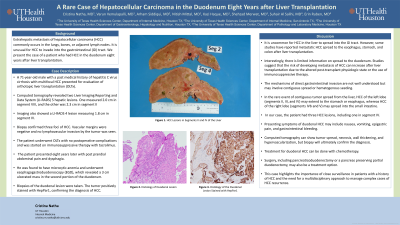Sunday Poster Session
Category: Liver
P1374 - A Rare Case of Hepatocellular Carcinoma in the Duodenum Eight Years After Liver Transplantation
Sunday, October 27, 2024
3:30 PM - 7:00 PM ET
Location: Exhibit Hall E

Has Audio

Cristina M. Natha, MD
University of Texas Health, McGovern Medical School
Houston, TX
Presenting Author(s)
Cristina M. Natha, MD1, Varun Vemulapalli, MD1, Arham Siddiqui, MD2, Nitish Mittal, MD1, Kazi Haque, MD1, Shehzad Merwat, MD3
1University of Texas Health, McGovern Medical School, Houston, TX; 2University of Texas Health San Antonio, San Antonio, TX; 3The University of Texas Health Sciences Center, Houston, TX
Introduction: Extrahepatic metastasis of hepatocellular carcinoma (HCC) is typically to the lungs, bone, or regional lymph nodes. It is unusual for HCC to invade into the gastrointestinal (GI) tract. We present the case of a patient who had HCC in the duodenum eight years after liver transplantation.
Case Description/Methods: A 71-year-old male with a history of hepatitis C virus cirrhosis with multifocal HCC underwent orthotopic liver transplantation. Regarding his HCC, imaging revealed two Liver Imaging Reporting and Data System (LI-RADS) 5 hepatic lesions. One measured 2.0 cm in segment VIII, and the other was 2.3 cm in segment II. Imaging also showed a LI-RADS 4 lesion measuring 1.8 cm in segment IV. Histology confirmed three foci of HCC. Vascular margins were negative and no lymphovascular invasion by the tumor was seen. The patient presented eight years later with abdominal pain and dysphagia. He was found to have microcytic anemia and underwent esophagogastroduodenoscopy (EGD), which revealed a 3 cm ulcerated mass in the second portion of the duodenum. Biopsies showed well differentiated HCC.
Discussion: It is uncommon for HCC in the liver to spread into the GI tract. However, some studies have reported metastatic HCC spread to the esophagus, stomach, and colon after liver transplantation. Interestingly, there is limited information on spread to the duodenum. Studies suggest that the risk of developing metastasis of HCC can increase after liver transplantation due to the altered post-transplant physiologic state or the use of immunosuppressive therapy. Furthermore, there is literature describing that, in the rare event of contiguous tumor spread from the liver, HCC of the left lobe (segments II, III, and IV) may extend to the stomach or esophagus, whereas HCC of the right lobe (segments IVb and V) may spread into the small intestine. In our case, the patient had three HCC lesions, including one in segment IV of the liver. Presenting symptoms of duodenal HCC may include nausea, vomiting, epigastric pain, and GI bleeding. Computed tomography can show tumor spread, necrosis, wall thickening, and hypervascularization, but biopsy will ultimately confirm the diagnosis. Treatment for duodenal HCC can be done with chemotherapy. Surgery, including pancreaticoduodenectomy or a pancreas preserving partial duodenectomy, may also be a treatment option. Ultimately, duodenal involvement of HCC is rare but should be considered as the source of nonspecific GI symptoms when more common causes have been ruled out.
Disclosures:
Cristina M. Natha, MD1, Varun Vemulapalli, MD1, Arham Siddiqui, MD2, Nitish Mittal, MD1, Kazi Haque, MD1, Shehzad Merwat, MD3. P1374 - A Rare Case of Hepatocellular Carcinoma in the Duodenum Eight Years After Liver Transplantation, ACG 2024 Annual Scientific Meeting Abstracts. Philadelphia, PA: American College of Gastroenterology.
1University of Texas Health, McGovern Medical School, Houston, TX; 2University of Texas Health San Antonio, San Antonio, TX; 3The University of Texas Health Sciences Center, Houston, TX
Introduction: Extrahepatic metastasis of hepatocellular carcinoma (HCC) is typically to the lungs, bone, or regional lymph nodes. It is unusual for HCC to invade into the gastrointestinal (GI) tract. We present the case of a patient who had HCC in the duodenum eight years after liver transplantation.
Case Description/Methods: A 71-year-old male with a history of hepatitis C virus cirrhosis with multifocal HCC underwent orthotopic liver transplantation. Regarding his HCC, imaging revealed two Liver Imaging Reporting and Data System (LI-RADS) 5 hepatic lesions. One measured 2.0 cm in segment VIII, and the other was 2.3 cm in segment II. Imaging also showed a LI-RADS 4 lesion measuring 1.8 cm in segment IV. Histology confirmed three foci of HCC. Vascular margins were negative and no lymphovascular invasion by the tumor was seen. The patient presented eight years later with abdominal pain and dysphagia. He was found to have microcytic anemia and underwent esophagogastroduodenoscopy (EGD), which revealed a 3 cm ulcerated mass in the second portion of the duodenum. Biopsies showed well differentiated HCC.
Discussion: It is uncommon for HCC in the liver to spread into the GI tract. However, some studies have reported metastatic HCC spread to the esophagus, stomach, and colon after liver transplantation. Interestingly, there is limited information on spread to the duodenum. Studies suggest that the risk of developing metastasis of HCC can increase after liver transplantation due to the altered post-transplant physiologic state or the use of immunosuppressive therapy. Furthermore, there is literature describing that, in the rare event of contiguous tumor spread from the liver, HCC of the left lobe (segments II, III, and IV) may extend to the stomach or esophagus, whereas HCC of the right lobe (segments IVb and V) may spread into the small intestine. In our case, the patient had three HCC lesions, including one in segment IV of the liver. Presenting symptoms of duodenal HCC may include nausea, vomiting, epigastric pain, and GI bleeding. Computed tomography can show tumor spread, necrosis, wall thickening, and hypervascularization, but biopsy will ultimately confirm the diagnosis. Treatment for duodenal HCC can be done with chemotherapy. Surgery, including pancreaticoduodenectomy or a pancreas preserving partial duodenectomy, may also be a treatment option. Ultimately, duodenal involvement of HCC is rare but should be considered as the source of nonspecific GI symptoms when more common causes have been ruled out.
Disclosures:
Cristina Natha indicated no relevant financial relationships.
Varun Vemulapalli indicated no relevant financial relationships.
Arham Siddiqui indicated no relevant financial relationships.
Nitish Mittal indicated no relevant financial relationships.
Kazi Haque indicated no relevant financial relationships.
Shehzad Merwat indicated no relevant financial relationships.
Cristina M. Natha, MD1, Varun Vemulapalli, MD1, Arham Siddiqui, MD2, Nitish Mittal, MD1, Kazi Haque, MD1, Shehzad Merwat, MD3. P1374 - A Rare Case of Hepatocellular Carcinoma in the Duodenum Eight Years After Liver Transplantation, ACG 2024 Annual Scientific Meeting Abstracts. Philadelphia, PA: American College of Gastroenterology.
